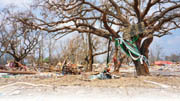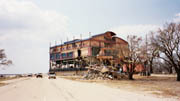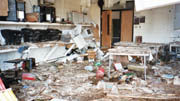
Thousands of damaged buildings were seen as our plane flew over the areas struck by Hurricane Katrina. Most of the news coverage took place in New Orleans and Biloxi; however, from our aerial view, vast areas of widespread damage spread through Alabama, Mississippi and Louisiana. ITW Buildex, my employer, sponsored me to participate in the wind damage research upon successful completion of wind damage investigation training. Our team determined failure modes and documented findings of systems that survived or failed during the storm. Engineers use such data to develop robust designs, new wind resistant products and revise building codes to provide increased protection from hurricane forces. Some companies conduct wind damage field research after major hurricanes and use in-house laboratory testing to determine how resistant wall panel assemblies and roof systems are to wind forces. Wall panel sections are mounted onto large laboratory test fixtures that are exposed to controlled wind forces, and thus provide wind load data and determine how much wind force the wall panel assemblies can withstand. Roof systems also undergo wind uplift testing. Laboratory and field data are used to develop enhanced wind resistant wall and roof systems.
To gather accurate field data after a hurricane, investigators must be onsite shortly after the hurricane event. Timing is important for the investigation to be accurate. Teams need to see the damage before debris is cleared and repairs are started. The standard protocol plan of our Hurricane Katrina trip consisted of daily round trips driving into Mississippi to conduct wind damage investigation research during daylight hours and return in the evening.

Investigation begins
The Hurricane Katrina investigation team selected a home base in Mobile, Ala., because electric, water and hotel rooms were available. The cab ride from the airport through Mobile toured around many damaged buildings. Numerous businesses could not operate due to damage or lack of electricity. Discussions with the cab driver included thoughts on the relief efforts and why many people did not want to evacuate before or after the hurricane. When the cab pulled up to the selected base hotel, it looked like the driver made a mistake. The hotel face was ripped off and at first glance looked deserted.The driver pulled further onto the hotel property and found it was open for business, although neighboring restaurants were closed or only accepting cash payment. Large debris, such as damaged commercial refrigerators, camped on the hotel walkways making the walk to the room an obstacle course. The hotel room carpet was full of drywall dust. The bathroom was missing its trim and did not have a light, which made taking a shower interesting. The disconnected telephone sat there as a prop. However, the room had working plumbing, electric and air conditioning.
The next morning, we stuffed our 4x4 vehicle with our gear, food, ice and water. We set our GPS and headed to Biloxi to go to the waterfront 34-story Imperial Palace Hotel and Casino, the tallest building in the city. Throughout Alabama and Mississippi, we saw damaged buildings and property loss. Traffic was horrendous. The roads were lined with building remnants. I expected to only see damage in a few towns. It was surprising to see the large area this storm covered. The 4x4s' signage, Department of Energy, and our Roofing Industry Committee On Weather Issues picture IDs opened up the roadblocks and gained us access onto the sites.
Our research focused on Mississippi, where we found many homes that remained standing but looked severely damaged. Hurricane winds and 30-foot high waves ripped window frames out. Furniture cast out onto lawns peppered the area. We also investigated essential buildings, such as schools.

Scanning the landscape, we found the Gulf beach to be nowhere in sight, which made it hard to imagine the storm traveling such a distance. We stood where the window used to be and could see into the classrooms. Books were sprawled in disarray hanging on the suspended ceiling supports, which somehow survived even though the roof above did not. All the classroom computers, desks and other equipment were covered in mud.
I walked across the remaining roof supports and found a plastic case labeled "Life Jackets," and began to imagine where it came from and how it landed there. Hallways were still flooded. The stench was so intense we could not step inside the building. Classrooms still had the children's artwork hanging from the grid work of the ceiling. The rooms and contents looked as if they were in a dirty, underwater city. During our investigation, a car pulled up, a man got out and asked us if we were hiring temporary help. But the Mississippi town residents displayed positive attitudes. Many continued to work even though they lost everything.
A National Guard truck pulled up while we recorded the design details onto the required 11-page inspection report. They saw the emblem on our truck and the U.S. DOE print on our shirts and offered us food. We were happy for the camaraderie but we did not accept. Taking even one meal from the residents would be too much.
Schools that were lucky enough to have minimal damage received lots of grooming from the National Guard. School buses loaded with troops and chainsaws lined the school parking lot. They cleaned the area meticulously and when they were done the school grounds looked manicured. All the fallen trees were removed so the kids could return to school. I had no idea that the National Guard performed such duties. Many schools were damaged beyond repair.
We continued to drive through Mississippi and found the Windgate Hotel. During our investigation, a maintenance man told me that during the storm the windows began to suck in. He said he had never seen anything like it.

Midday agenda
It was lunchtime, so we drove through other towns until we found the only open restaurant, an Applebee's that had a special permit. They had a limited menu, canned soda, bottled water, paper plates and plastic ware. The employees were pleased to be operating the restaurant. The lights went out and the waitress said, "Don't worry it will come back on." She was right. Before the room heated up, the AC and lights were back on line.We headed back out towards the Gulf. We found the streets near and on the Gulf coast scattered with debris.
The landscape looked like winter, as trees that remained standing were leafless and would have looked naked but each limb, branch and twig were covered with clothing, drapery and numerous other debris as far as could be seen. The trees must have acted as filters while the area was underwater. No leaves were on the ground either. Even the pine trees were missing all their needles. All the foliage was washed away. Thousands of fallen trees buried neighborhoods.
Roads were blocked by boats, trees, electrical poles and downed wires. We had to drive over electrical wires to gain access to our destinations. Houses and yards were buried under the fallen trees and debris. The National Guard and local churches were peppered through the area supplying food and water. They were all helping the community in numerous ways. Many of them were cutting up fallen trees and branches, which was essential to getting in and out of these areas. House searches were conducted and homes were marked with red spray paint to indicate the living and the dead. Local charities lined street corners with cases of bottled water. These organizations offered food and water to all.

One homeless site had a tent pitched on top of its foundation. The area around the tent was surrounded with the typical camping gear including a BBQ grill. The site was identified with a spray painted sign. These people had no intention of leaving, just like the people still living in remains of their damaged homes. The mass population was working to clean up what was left of their land, homes and businesses.
Massive casino barges were beached on land far from their moorage. The barges were stuck up against buildings that must have acted like a pier during the high waves. We wondered how these would be removed from dry land. Some looked like skeletons because their exterior walls were missing with only a framework of exterior steel studs remaining. Many buildings experienced high winds and 30-foot waves, which ripped sheathing from their walls, leaving only the steel studs behind.
Numerous boats were piled on each other and scattered over land. Many houses collapsed. Properties and schools that were above sea level and not in eyesight distance of the Gulf were also severely damaged and in many cases totaled. We went through several towns surrounding Biloxi and found immense damage everywhere. A four-story building had one corner from top to bottom gone and somehow remained standing. The storm removed structures on and near the Gulf-a seemingly endless distance-making us realize the overwhelming magnitude of the storm.
We reached the waterfront Imperial Palace in Biloxi and found the calm Gulf to be deceiving. The grounds and driveway were coated in thick mud. Bulldozers moved the mud aside which allowed people and vehicles access. Workers were inside doing what they could to begin the clean up. The outside of the building looked battered. Generators ran lights that operated one elevator. The inside of the first floor was unrecognizable. Flood lines and mud covered the area. We made it through the debris and to the top of the building and conducted our investigation. Analysis and data collected by the certified volunteer members was formalized and compiled into a master report.

Damage everywhere
We drove for three days through many towns and found colossal damage in numerous areas. Each night ended with going over the design details and analysis for each building, entering the data into the computer spread sheet and downloading the pictures of the damage details to be used for future design improvements. Gulf Port, Biloxi and D'Iberville were just a few of the destroyed areas. We were able to enter most of the buildings identified for our investigation. While we walked through one of the hotels in Biloxi, a structural engineer called for an evacuation of the building so all the workers had to leave. The area was still without water and electric.Some of the casino hallways in Biloxi were pitch-black. In order to pass through, we had to walk in the dark while listening to the thick, rich mud gush under our feet and wondered if there were any alligators or snakes present, since some were spotted earlier in parking lots. Gambling tables were in disarray pilled on top of each other, full of mud. After we finished our report we drove along the coastal road and found homes leaning and totaled.
There were so many buildings damaged that it was easier to count the undamaged, which in some areas was zero. Some were damaged beyond repair; many were gone only leaving behind a foundation. A few had minimal damage. People used torn plywood and red paint to stake their land and display their address. Some signs were also labeled with the name of their insurance company. Insurance companies, such as State Farm, had booths set up on neighborhood streets to help people with their claims. As we drove further down the coast it got worse. There were no hotels, casinos or homes left. All that remained were miles of naked beach. The National Guard troops told us from there on out no structures were left. The storm, with its massive waves, wiped that part of the earth clean. A few miles down the road, we found the street to be buckled, folded and failed. The "road" was non-existent. We had to turn around.
Our team spent the evenings compiling our findings into a 120-page report indicating damage initiation and root cause of system failure. The detailed report is under the review of the Oak Ridge National Laboratory. Findings are used to revise building codes and direct new product development.
On August 29, 2005, nature cleared the shores of Mississippi and Louisiana. Even inland and above sea level houses were destroyed. Areas near and far from the Gulf were severely impacted and full recovery will take years of dedication.
If you read this article, please circle number 338.

Report Abusive Comment